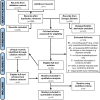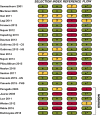Diagnostic accuracy of the WHO clinical definitions for dengue and implications for surveillance: A systematic review and meta-analysis
- PMID: 33901191
- PMCID: PMC8102005
- DOI: 10.1371/journal.pntd.0009359
Diagnostic accuracy of the WHO clinical definitions for dengue and implications for surveillance: A systematic review and meta-analysis
Abstract
Background: Dengue is the world's most common mosquito-borne virus but remains diagnostically challenging due to its nonspecific presentation. Access to laboratory confirmation is limited and thus most reported figures are based on clinical diagnosis alone, the accuracy of which is uncertain. This systematic review assesses the diagnostic accuracy of the traditional (1997) and revised (2009) WHO clinical case definitions for dengue fever, the basis for most national guidelines.
Methodology/principal findings: PubMed, EMBASE, Scopus, OpenGrey, and the annual Dengue Bulletin were searched for studies assessing the diagnostic accuracy of the unmodified clinical criteria. Two reviewers (NR/SL) independently assessed eligibility, extracted data, and evaluated risk of bias using a modified QUADAS-2. Additional records were found by citation network analysis. A meta-analysis was done using a bivariate mixed-effects regression model. Studies that modified criteria were analysed separately. This systematic review protocol was registered on PROSPERO (CRD42020165998). We identified 11 and 12 datasets assessing the 1997 and 2009 definition, respectively, and 6 using modified criteria. Sensitivity was 93% (95% CI: 77-98) and 93% (95% CI: 86-96) for the 1997 and 2009 definitions, respectively. Specificity was 29% (95% CI: 8-65) and 31% (95% CI: 18-48) for the 1997 and 2009 definitions, respectively. Diagnostic performance suffered at the extremes of age. No modification significantly improved accuracy.
Conclusions/significance: Diagnostic accuracy of clinical criteria is poor, with significant implications for surveillance and public health responses for dengue control. As the basis for most reported figures, this has relevance to policymakers planning resource allocation and researchers modelling transmission, particularly during COVID-19.
Conflict of interest statement
The authors have declared that no competing interests exist.
Figures




Similar articles
-
Evaluation of the diagnostic utility of the traditional and revised WHO dengue case definitions.PLoS Negl Trop Dis. 2013 Aug 22;7(8):e2385. doi: 10.1371/journal.pntd.0002385. eCollection 2013. PLoS Negl Trop Dis. 2013. PMID: 23991237 Free PMC article.
-
Thoracic imaging tests for the diagnosis of COVID-19.Cochrane Database Syst Rev. 2020 Nov 26;11:CD013639. doi: 10.1002/14651858.CD013639.pub3. Cochrane Database Syst Rev. 2020. Update in: Cochrane Database Syst Rev. 2021 Mar 16;3:CD013639. doi: 10.1002/14651858.CD013639.pub4. PMID: 33242342 Updated.
-
Distinguishing non severe cases of dengue from COVID-19 in the context of co-epidemics: A cohort study in a SARS-CoV-2 testing center on Reunion island.PLoS Negl Trop Dis. 2021 Apr 26;15(4):e0008879. doi: 10.1371/journal.pntd.0008879. eCollection 2021 Apr. PLoS Negl Trop Dis. 2021. PMID: 33901185 Free PMC article.
-
Rapid immunochromatographic tests for the diagnosis of dengue: a systematic review and meta-analysis.Cad Saude Publica. 2020 Jun 8;36(6):e00225618. doi: 10.1590/0102-311X00225618. eCollection 2020. Cad Saude Publica. 2020. PMID: 32520127
-
Thoracic imaging tests for the diagnosis of COVID-19.Cochrane Database Syst Rev. 2020 Sep 30;9:CD013639. doi: 10.1002/14651858.CD013639.pub2. Cochrane Database Syst Rev. 2020. Update in: Cochrane Database Syst Rev. 2020 Nov 26;11:CD013639. doi: 10.1002/14651858.CD013639.pub3. PMID: 32997361 Updated.
Cited by
-
Sentinel Enhanced Dengue Surveillance System - Puerto Rico, 2012-2022.MMWR Surveill Summ. 2024 May 30;73(3):1-29. doi: 10.15585/mmwr.ss7303a1. MMWR Surveill Summ. 2024. PMID: 38805389 Free PMC article.
-
A Cross-Sectional Study on Bedside Abdominal Ultrasound Findings as a Diagnostic and Prognostic Tool in Dengue Fever in Manipal Hospital, Bengaluru, India.Cureus. 2024 Jul 17;16(7):e64734. doi: 10.7759/cureus.64734. eCollection 2024 Jul. Cureus. 2024. PMID: 39156261 Free PMC article.
-
Cost-effectiveness analysis of a multiplex lateral flow rapid diagnostic test for acute non-malarial febrile illness in rural Cambodia and Bangladesh.Lancet Reg Health Southeast Asia. 2024 Mar 16;23:100389. doi: 10.1016/j.lansea.2024.100389. eCollection 2024 Apr. Lancet Reg Health Southeast Asia. 2024. PMID: 38523864 Free PMC article.
-
A machine learning model to assess potential misdiagnosed dengue hospitalization.Heliyon. 2023 May 30;9(6):e16634. doi: 10.1016/j.heliyon.2023.e16634. eCollection 2023 Jun. Heliyon. 2023. PMID: 37313173 Free PMC article.
-
Dengue in Myanmar: Spatiotemporal epidemiology, association with climate and short-term prediction.PLoS Negl Trop Dis. 2023 Jun 5;17(6):e0011331. doi: 10.1371/journal.pntd.0011331. eCollection 2023 Jun. PLoS Negl Trop Dis. 2023. PMID: 37276226 Free PMC article.
References
Publication types
MeSH terms
Grants and funding
LinkOut - more resources
Full Text Sources
Other Literature Sources
Medical
Research Materials

